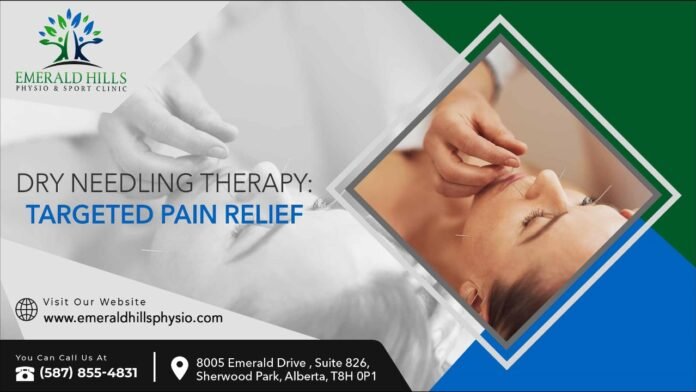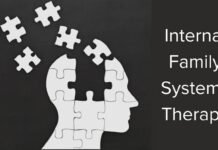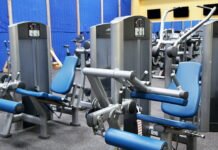Last Updated on March 12, 2024 by admin
In the constantly evolving realm of dry needling therapy, new techniques emerge to address the diverse needs of patients. One such technique that has garnered significant attention for its effectiveness is Dry Needling. Especially in centres like Emerald Hills Physiotherapy Sherwood Park, patients experience firsthand the transformative potential of this therapy.
Table of Contents
Understanding Dry Needling
Dry Needling, distinct from acupuncture, is a treatment designed to ease muscular pain. Its primary aim is to release or inactivate muscle trigger points, thus relieving pain or improving range of motion. Through the insertion of a needle into these trigger points, Dry Needling can provide relief for various musculoskeletal problems.
The Science Behind Dry Needling
When our muscles form trigger points, they often cause pain and discomfort. These are essentially tight spots within the muscle fibre that can also lead to referred pain in distant parts of the body. Dry Needling therapy seeks to address these knots or bands of muscle by stimulating them with a needle. This leads to the muscle relaxing, thereby alleviating tension and pain.
Common Conditions Addressed by Dry Needling
Dry needling is a versatile therapeutic approach that caters to a diverse range of musculoskeletal conditions. Some prevalent conditions include:
- Chronic Back Pain: Persistent pain in the lumbar or thoracic regions of the spine can be alleviated using dry needling. By targeting trigger points in the surrounding musculature, the therapy can relieve tension and improve mobility.
- Tension Headaches and Migraines: Trigger points in the neck and shoulders often contribute to tension headaches and migraines. Dry needling can provide immediate relief by releasing these tight muscle bands.
- Tennis Elbow (Lateral Epicondylitis): This condition arises due to repetitive strain on the forearm muscles, leading to pain in the elbow’s outer region. Dry needling can expedite the healing process by targeting the affected areas.
- Plantar Fasciitis: This painful condition affects the heel and underside of the foot. Dry needling can help alleviate the pain by treating the tight muscles and fascia in the foot.
- Myofascial Pain Syndrome: Characterized by pressure on sensitive points in your muscles (trigger points), this condition can cause pain in unrelated body parts. Dry needling aims to release these trigger points, alleviating the pain.
- Shin Splints: Often affecting athletes and runners, this condition involves pain along the shin bone. Dry needling can help relax the muscles of the shin and promote healing.
What Does Dry Needling Therapy Help With?
- Immediate Pain Relief: For many patients, even a single session can result in noticeable pain reduction.
- Increased Range of Motion: As the muscle tension reduces, many find their mobility improves.
- Reduction in Muscle Stiffness: By addressing the root cause – trigger points – muscle stiffness diminishes.
- Enhanced Blood Flow: The therapy can stimulate increased blood flow to the treated areas.
- Decreased Muscle Tension: Regular sessions can result in sustained muscle relaxation and reduced tension.
- Enhancement of Other Therapies: When combined with other treatments like manual therapy or exercise, dry needling can amplify the therapeutic outcomes.
- Minimal Side Effects: Compared to medications or surgical interventions, dry needling has minimal side effects when performed by trained professionals.
- Promotes Natural Healing: Dry needling encourages the body’s innate healing mechanisms, enhancing the recovery of injured tissues.
- Addresses Underlying Causes: Unlike some treatments that merely mask pain, dry needling aims to treat the root cause of the pain, offering longer-lasting relief.
IMS Therapy: A Deep Dive
Intramuscular Stimulation (IMS) targets neuropathic pain, which arises when nerves malfunction. Physiotherapists employ IMS therapy Sherwood Park to treat chronic pain conditions, providing patients with a therapeutic option that reaches the nerve level of their pain.
During a dry needling session the initial step involves a thorough assessment of the patient’s medical history and pain nature, ensuring the treatment’s suitability. The physiotherapist then identifies the relevant trigger points or muscle tightness through palpation and movement tests. Sterile, thin needles are subsequently inserted into these trigger points, often causing a brief twitch or cramp sensation indicative of effective treatment. Post needle removal, slight soreness might be experienced, but it generally fades within a day. Aftercare, including stretches or heat/cold applications, may be recommended to augment the treatment benefits.
Distinguishing Dry Needling from Acupuncture
While both acupuncture and dry needling use thin, stainless steel needles, their applications and methodologies differ. Acupuncture, rooted in Traditional Chinese Medicine, focuses on the body’s energy flow or ‘chi.’ Conversely, Dry Needling has its roots in anatomical and neurophysiological principles.
Safety and Considerations
While Dry Needling offers myriad benefits, ensuring it’s executed by trained professionals is essential. Physiotherapists emphasize patient safety, with experienced therapists who are well-versed in the technique, ensuring minimal discomfort and maximized benefits.
Embracing Therapeutic Techniques
Dry Needling, especially as practiced in esteemed establishments like Emerald Hills Physiotherapy Sherwood Park, stands as a testament to the progressive strides physiotherapy continues to make. For those battling persistent muscular or neuropathic pain, it offers a beacon of hope, providing targeted and efficient relief. As we continue to understand better the complexities of the human body, therapies like Dry Needling Sherwood Park pave the way for innovative, effective, and patient-centric care solutions.
Apart from that, if you are interested to know about Dry Needling Vs. Acupuncture: The Difference then visit our Health category.






















